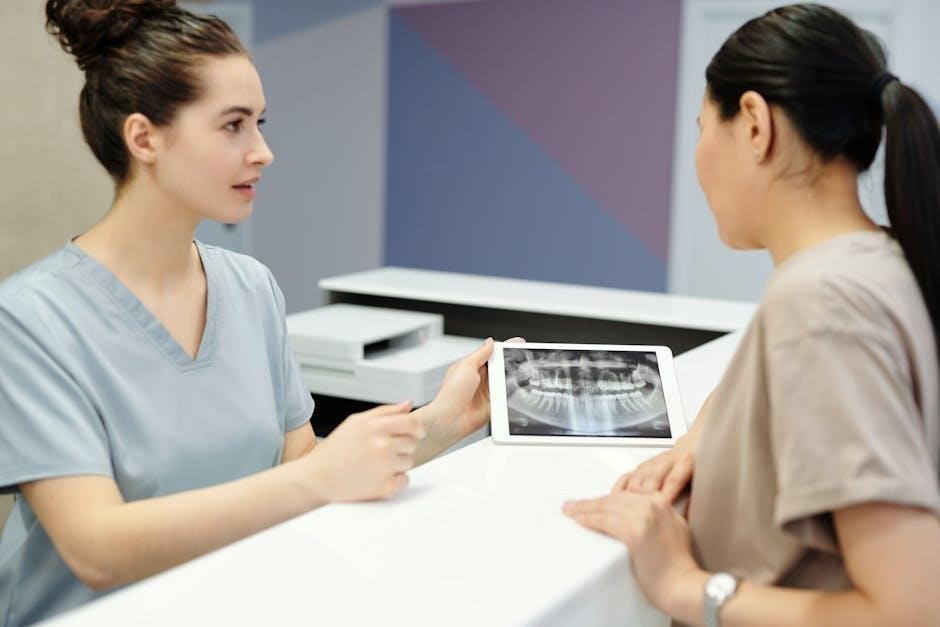The dental front desk training manual PDF is a comprehensive guide designed to enhance the skills of dental office staff. It covers essential tasks, routines, and best practices to ensure efficient patient flow, effective communication, and streamlined operations. This resource is tailored to help front desk professionals master scheduling, billing, and patient engagement while maintaining compliance with dental practice standards. By following this manual, your team can improve patient satisfaction and office efficiency, ensuring a smooth and professional experience for everyone involved.
1.1 Importance of Front Desk Training in Dental Practices
Front desk training is crucial for dental practices as it ensures staff can manage patient interactions, scheduling, and billing efficiently; Proper training enhances patient satisfaction, reduces errors, and improves office workflow. A well-trained front desk team acts as the practice’s first impression, fostering trust and loyalty. Effective training also ensures compliance with dental regulations and maintains confidentiality, which are essential for a professional and successful dental practice environment.
1.2 Overview of the Dental Front Desk Training Manual PDF
The Dental Front Desk Training Manual PDF is a detailed resource offering step-by-step guidance for front desk professionals. It covers essential tasks like scheduling, patient communication, and insurance verification, while providing checklists, templates, and best practices. This comprehensive guide is designed to help teams master daily routines, improve patient satisfaction, and maintain compliance with dental practice standards, ensuring a smooth and efficient workflow.

Core Skills for Dental Front Desk Professionals
The Dental Front Desk Training Manual PDF is a comprehensive guide designed to equip front desk professionals with essential skills and knowledge. It covers key areas such as appointment scheduling, patient communication, and insurance verification, providing detailed checklists, templates, and best practices. This resource ensures teams can master daily routines, improve patient satisfaction, and maintain compliance, ultimately enhancing office efficiency and workflow.
2.1 Dental Scheduling and Appointment Management
Dental scheduling and appointment management are critical skills for front desk professionals. The manual emphasizes strategies to minimize no-shows, optimize time slots, and ensure smooth patient flow. It provides tips for effective communication during scheduling, such as confirming appointments and managing cancellations; Additionally, it covers how to use dental practice management software to streamline scheduling processes and maximize office efficiency. Proper scheduling ensures a balanced workload and better patient care.
2.2 Patient Communication and Customer Service
Effective patient communication and customer service are vital for a positive dental office experience. The manual highlights techniques for clear, empathetic interactions, ensuring patients feel valued and informed. It emphasizes active listening, addressing concerns promptly, and maintaining professionalism. Additionally, it provides strategies for handling difficult situations and ensuring patient satisfaction. Excellent communication fosters trust and loyalty, contributing to long-term patient retention and a reputable dental practice.
2.3 Insurance Verification and Billing Processes
Accurate insurance verification and efficient billing processes are critical for seamless dental office operations. The manual guides front desk staff on verifying coverage, understanding billing codes, and managing claims. It emphasizes attention to detail to prevent errors and delays. Clear procedures ensure timely payments and compliance with dental practice regulations, maintaining patient trust and financial stability for the practice.
2.4 HIPAA Compliance and Patient Confidentiality
HIPAA compliance is essential for protecting patient confidentiality. The manual outlines protocols for handling sensitive information, ensuring all front desk staff understand their roles in maintaining privacy. It covers secure data storage, authorized disclosures, and proper communication practices. Training emphasizes the importance of adhering to these standards to avoid legal issues and build patient trust in the dental practice.

Daily Front Desk Duties and Routines
Daily front desk duties include managing patient check-ins, scheduling appointments, handling calls, and maintaining records. These routines ensure smooth operations and a positive patient experience.
3.1 Morning and End-of-Day Routines
Starting the day, the front desk should organize patient records, review the schedule, and prepare necessary materials. End-of-day tasks include updating records, securing patient data, and preparing for the next day. These routines ensure a smooth transition and maintain office efficiency.
3.2 Managing Patient Check-In and Check-Out
Efficiently manage patient check-in by warmly greeting them, verifying details, and handling paperwork. Ensure all necessary forms are completed and updates to patient records are made. During check-out, confirm future appointments, provide treatment instructions, and handle payments. Maintain a smooth process to ensure patient satisfaction and a seamless experience from arrival to departure.
3.4 Handling Patient Calls and Messages
Mastering patient communication is crucial. Answer calls promptly, use professional phone etiquette, and ensure clear, concise messaging. Train staff to handle inquiries efficiently, confirming appointments and addressing concerns. Utilize dental software to manage voicemails and messages, ensuring timely responses. Implement effective communication strategies to enhance patient satisfaction and maintain seamless office operations. Regular training on call handling can improve patient engagement and overall practice efficiency.
Effective Patient Flow Management
Efficient patient flow is vital for a smooth dental practice. Streamline arrival and departure, minimize wait times, and optimize scheduling. Proper management ensures timely care delivery, improving patient satisfaction and office productivity.
4.1 Streamlining Patient Arrival and Departure
Streamlining patient arrival and departure is crucial for a seamless dental practice experience. Ensure a smooth check-in process by verifying patient information beforehand and using efficient procedures. Guide patients through necessary paperwork and preparations promptly. A well-organized arrival process sets the tone for their visit, while a streamlined departure ensures clear communication about follow-ups and payments, enhancing overall patient satisfaction and office efficiency.
4.2 Managing Wait Times and Reducing Delays
Effectively managing wait times is essential for maintaining patient satisfaction and office efficiency. Confirm appointments in advance to minimize no-shows and reschedule as needed. Ensure all necessary preparations are made before the patient arrives. Communicate delays promptly, offering clear explanations and updates. Implement a system to track and address bottlenecks, and use technology to streamline scheduling. Proactive management of wait times enhances patient trust and ensures a smoother workflow.

Financial and Billing Procedures
Understanding dental billing codes and managing patient payments are crucial for a smooth financial workflow. Ensure accurate insurance verification and maintain detailed records for transparency and compliance.
5.1 Understanding Dental Billing Codes
Understanding dental billing codes is essential for accurate insurance claims and patient billing. Familiarize yourself with CDT codes, ICD codes, and ADA standards to ensure proper documentation. Accurate coding prevents errors and ensures compliance with dental billing regulations.
Regular updates and training on coding changes are crucial for front desk staff to maintain efficiency and avoid claim rejections. Always double-check codes before submission to ensure a smooth billing process and enhanced patient satisfaction.
5.2 Managing Patient Payments and Collections
Effective management of patient payments and collections is critical for maintaining a smooth financial workflow. Ensure all payments are processed accurately, and receipts are issued promptly. Verify insurance coverage and patient responsibility before procedures. Clear communication about payment options and financial policies helps reduce misunderstandings. Regularly review accounts to identify unpaid balances and follow up with patients to resolve them efficiently.
Utilize dental practice management software to track payments, generate statements, and send reminders. Transparency and professionalism in handling patient finances foster trust and long-term relationships. Always maintain accurate records and comply with financial regulations to ensure a seamless payment process.
Technology and Software Utilization
Modern dental practices rely on advanced software for efficient operations. Dental practice management systems streamline scheduling, billing, and patient records. EHR integration enhances data accuracy and accessibility, improving patient care and office efficiency while reducing administrative burdens.
6.1 Dental Practice Management Software
Dental practice management software is essential for streamlining front desk operations. It handles appointment scheduling, patient records, billing, and insurance claims. Features like automated reminders and real-time reporting improve efficiency. Training staff on this software ensures accurate data entry and effective patient communication, reducing errors and enhancing overall practice performance. Regular updates and support are crucial for maintaining optimal functionality and compliance with industry standards.
6.2 Electronic Health Records (EHR) Integration
Electronic Health Records (EHR) integration streamlines patient data management by linking dental software with patient records. This ensures accurate, real-time information sharing, reducing manual entry and errors. EHR systems enhance data security and compliance with regulations like HIPAA. Proper training on EHR integration is vital for front desk staff to efficiently manage patient records, improving overall practice operations and patient care quality. Regular updates and training ensure seamless functionality and compliance.

Hiring and Onboarding Front Desk Staff
Hiring and onboarding front desk staff involves identifying key qualities, creating effective job postings, and implementing comprehensive training programs to ensure seamless integration into dental office operations.
7.1 Key Qualities to Look for in Front Desk Candidates
When hiring front desk staff, prioritize candidates with excellent communication skills, attention to detail, and organizational abilities. They should be patient, empathetic, and adept at handling multiple tasks. Proficiency in basic software and dental practice management systems is essential. A positive attitude, willingness to learn, and ability to maintain confidentiality are also critical. Ensure they can work well under pressure and provide a welcoming experience for patients.
7.2 Onboarding Checklist for New Employees
A comprehensive onboarding checklist ensures new front desk staff are well-prepared. Include system training, policy reviews, and shadowing experienced team members. Provide hands-on practice with scheduling and patient communication. Ensure they understand HIPAA compliance and office procedures. Schedule regular feedback sessions and offer ongoing support. This structured approach helps new employees transition smoothly into their roles, fostering confidence and competence from day one.

Training and Development
Effective training is crucial for front desk success. Avoid lengthy sessions; opt for microlearning to enhance retention and adapt to busy schedules, ensuring continuous skill improvement.
8.1 Avoiding Sporadic or Lengthy Training Sessions
Sporadic or lengthy training sessions can hinder retention and engagement. Opt for concise, focused microlearning sessions to ensure staff can absorb information without feeling overwhelmed. This approach promotes better retention and practical application, allowing front desk teams to master skills efficiently while balancing daily tasks. The dental front desk training manual PDF emphasizes structured, bite-sized learning to enhance productivity and effectiveness in dental office management.
8.2 Microlearning for Front Desk Training
Microlearning is a highly effective approach for front desk training, breaking learning into short, focused sessions. With SC Training (formerly EdApp), you can create engaging microlessons from dental front desk training manual templates. This method enhances retention, reduces overwhelm, and allows staff to apply knowledge immediately. The dental front desk training manual PDF supports this approach, ensuring practical, efficient skill development for a more professional and efficient dental office team.
Patient Engagement and Satisfaction
Effective patient engagement begins with a warm greeting and clear communication. The dental front desk training manual PDF emphasizes guiding patients through check-in and ensuring personalized care to enhance satisfaction and build trust.
9.1 Best Practices for Patient Communication
Effective patient communication starts with clear and concise messaging. Use active listening skills, maintain eye contact, and address patients by name to build rapport. Be transparent about treatment plans, costs, and procedures to ensure understanding. Employ positive language and empathetic tone, especially when discussing sensitive topics. Regularly check for patient concerns and provide reassurance. Following up post-appointment strengthens trust and satisfaction, ensuring a positive dental experience.
9.2 Handling Patient Complaints and Concerns
Address patient complaints with empathy and professionalism. Listen actively to understand their concerns, acknowledge their feelings, and respond promptly. Offer solutions or alternatives to resolve issues efficiently. Document all interactions for future reference and ensure follow-up to confirm satisfaction. Maintain calm and composure, even in challenging situations, to uphold the practice’s reputation and patient trust. Training in conflict resolution can enhance your team’s ability to manage difficult interactions effectively.

Emergency and Urgent Care Protocols
This section outlines protocols for handling dental emergencies and urgent care situations; It emphasizes staying calm, assessing the situation, notifying the dental team promptly, and providing clear instructions to ensure patient safety and effective care.
10.1 Handling Dental Emergencies at the Front Desk
Staying calm and composed is crucial when handling dental emergencies. Assess the situation promptly, notify the dental team immediately, and provide clear instructions to the patient. Ensure patient records are easily accessible and maintain confidentiality. Guide patients to the treatment area efficiently and prepare necessary documentation. Effective communication and quick actions ensure timely care and patient safety, adhering to dental practice protocols and HIPAA guidelines.
10.2 Communication Strategies for Urgent Cases
Clear and concise communication is key in urgent situations. Front desk staff should actively listen to patients, ask relevant questions, and remain empathetic. Provide prompt updates on wait times and treatment readiness. Avoid jargon, ensuring instructions are easy to understand. Maintain patient confidentiality while coordinating with the clinical team. Effective communication helps reduce anxiety, builds trust, and ensures seamless care transitions during urgent cases.

Legal and Ethical Considerations
Understanding dental ethics and professionalism is crucial for front desk staff. Compliance with regulations ensures patient trust and avoids legal issues, maintaining a reputable practice environment.
11.1 Understanding Dental Ethics and Professionalism
Understanding dental ethics and professionalism is the foundation of a successful dental practice. Front desk staff must uphold confidentiality, transparency, and respect in all interactions. Adhering to ethical standards ensures patient trust and satisfaction, while also protecting the practice from legal issues. This section emphasizes the importance of maintaining professionalism and integrity in daily operations, ensuring compliance with dental ethics and fostering a positive practice reputation.
11.2 Compliance with Dental Practice Regulations
Compliance with dental practice regulations is essential for maintaining legal and ethical standards. The manual emphasizes adherence to HIPAA guidelines, patient confidentiality, and proper documentation. Front desk staff must understand and follow regulations regarding patient records, billing, and emergency protocols. Non-compliance can lead to legal issues, while proper adherence ensures patient trust and operational efficiency. This section underscores the importance of staying updated on regulatory changes to avoid penalties.
Marketing and Patient Acquisition
The front desk plays a crucial role in patient acquisition by effectively handling phone calls, managing first impressions, and ensuring seamless follow-ups. Personalized communication and proactive engagement are key to attracting and retaining patients, enhancing the practice’s reputation and growth.
12.1 Role of the Front Desk in Patient Retention
The front desk staff plays a vital role in patient retention by ensuring exceptional customer service, managing patient interactions, and maintaining open communication. Greeting patients warmly, efficiently handling check-ins, and addressing concerns promptly contribute to a positive experience. Following up with patients post-appointment and keeping accurate records also fosters trust and satisfaction. A well-trained front desk team can significantly enhance patient loyalty and retention, making them a valuable asset to the dental practice.
12.2 Promoting Dental Services Effectively
Promoting dental services effectively involves clear communication of treatment options and benefits. Front desk staff should highlight specials, educate patients on available services, and use social media to engage the community. Personalized recommendations and timely reminders can also encourage patients to book additional treatments. By effectively marketing dental services, the front desk can increase patient interest, boost appointments, and contribute to practice growth while maintaining a patient-centered approach.

Team Collaboration and Communication
Effective collaboration between the front desk and clinical staff is crucial for seamless patient care. Open communication and teamwork ensure efficient coordination of tasks and improved office efficiency.
13.1 Building a Cohesive Front Desk Team
Building a cohesive front desk team requires clear roles, open communication, and shared goals. Regular team-building activities and cross-training ensure that each member understands their responsibilities and works collaboratively. This fosters a supportive environment where the team can efficiently handle patient flow, scheduling, and communication, ultimately enhancing the overall dental practice experience for both staff and patients. Training manuals and checklists provide consistency and guidance.
13.2 Improving Communication with Clinical Staff
Effective communication between the front desk and clinical staff is vital for seamless patient care. Regular meetings, clear messaging, and active listening ensure alignment on patient needs and schedules. Using specific terminology and maintaining updated records help prevent misunderstandings. Encouraging open dialogue and feedback fosters collaboration, enhancing overall efficiency and patient satisfaction. This teamwork ensures a smooth workflow and positive outcomes for both staff and patients.

Continuous Improvement and Feedback
Regular performance reviews and constructive feedback are essential for growth. Implementing suggestions and fostering a culture of continuous learning ensures ongoing improvement and team success.
14.1 Regular Performance Reviews for Front Desk Staff
Regular performance reviews are crucial for assessing front desk staff’s strengths and areas for improvement. These reviews help set clear goals, enhance skills, and ensure consistent high standards. By providing constructive feedback, practices can improve team performance, patient satisfaction, and overall efficiency, fostering a culture of continuous growth and professionalism. Regular check-ins also help in addressing challenges promptly and recognizing achievements, leading to a more motivated and effective front desk team.
14.2 Implementing Feedback for Process Improvement
Implementing feedback is essential for enhancing front desk operations and patient satisfaction. Regularly collected insights help identify inefficiencies and areas for improvement. By acting on this feedback, practices can refine processes, reduce delays, and enhance patient experiences. Utilizing tools like dental practice management software and EHR integration supports data-driven decisions, ensuring continuous improvement and compliance with dental standards. This proactive approach fosters a culture of adaptability and excellence in front desk management.
The front desk plays a vital role in dental practice success, ensuring smooth operations and patient satisfaction. Effective management and continuous improvement strategies empower the team for long-term success.
15.1 The Role of Front Desk in Dental Practice Success
The front desk is crucial in dental practice success, serving as the first point of contact and setting the tone for patient experiences. Effective front desk management ensures smooth operations, from scheduling appointments to handling billing and patient communication. A well-trained team enhances patient satisfaction, builds loyalty, and contributes to the overall growth and efficiency of the dental practice.
15.2 Final Tips for Effective Front Desk Management
Implement microlearning for continuous skill improvement, ensuring staff stays updated on best practices. Foster a welcoming environment by greeting patients warmly and addressing their needs promptly. Maintain organization and confidentiality, adhering to HIPAA standards. Regularly review and refine processes to optimize efficiency. Encourage open communication between front desk and clinical teams to ensure seamless patient care. These strategies will enhance overall practice success and patient satisfaction.
